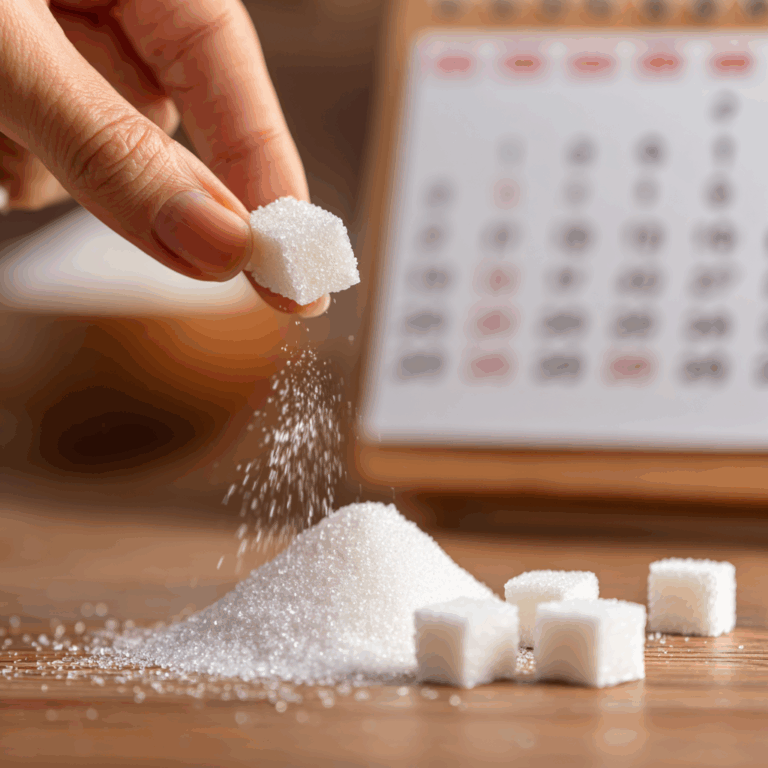By Mike, The SugarFreeMan
Founder of SugarDetox.com and the 30-Day Sugar Freedom Challenge
When I first got clean and sober, I was not a huge fan of this idea.
The idea being that I had, through the use of mood and mind-altering substances, stunted my ability to deal with difficult emotions that arose in my life and taught myself – or adapted to – a method of dealing with them through the use of substances.
It seemed like so much psycho-babble to me at the time.
I drink, I fall down, I crash cars and piss off all my friends and family. What do my feelings have to do with that?
It took me a good long time to grasp the concept and even longer to embrace it.

But here’s what I learned after 35 years sugar-free and helping tens of thousands of people break free from sugar addiction: “Stuffing your feelings” with sugar isn’t psycho-babble. It’s the core issue that keeps people trapped in the yo-yo diet cycle for decades.
Understanding this connection between emotions and sugar – really understanding it, not just intellectually but in your gut – is what separates the 2% who succeed long-term from the 98% who keep returning to sugar.
This article was review by Dr. Camela McGrath, MD, FACOG. Find more about her here
So What Does it Really Mean to “Stuff Your Feelings” with Sugar?
We hear this phrase a lot.
The idea that eating lots of sugar or carbs, drinking alcohol, or using drugs is an attempt to “stuff our feelings.”
What the hell does that even mean?
The short version is this: we learned that things that make us feel better about ourselves – even if they’re temporary – are what we go to in times of stress, grief, and any generally tough times.
There can be positive ways to deal with the same emotions too – running, walking, yoga, meditation, hot baths, calling a friend – the list is endless.
The difficulty arises when folks just don’t consider sugar as powerful enough to hold back or cover up bad feelings… or otherwise make us feel that much better.
Well, I beg to differ. And you will too if you just honestly look back on your history.
Look at Your Own History (Be Honest)
Think about it:
- First boyfriend breakup? Girls’ ice cream party.
- Boss yells at you? Trip to the vending machines.
- Husband still just as big a pain in the ass as yesterday? Half gallon of ice cream, sitting watching TV alone.
- Just sad about life? Sugar, sugar, sugar.
This isn’t coincidence. This is learned behavior that’s been reinforced thousands of times over your lifetime.
From the time you were a child, you learned:
- Scraped knee? Here’s a lollipop
- Bad day at school? Let’s get ice cream
- Did something good? Celebrate with cake
- Feeling sick? Here’s some ginger ale and popsicles
- Holiday or special occasion? Centered around dessert
By the time you’re an adult, the pattern is so deeply ingrained you don’t even notice it anymore. You don’t consciously think “I’m stuffing my feelings.” You just automatically reach for sugar when emotions get uncomfortable.
Harvard Medical School research shows that sugar rapidly increases serotonin and dopamine levels in the brain, creating a temporary mood boost. Your brain learns: uncomfortable emotion → eat sugar → feel better (temporarily).
After thousands of repetitions, it becomes automatic. You’re not even aware you’re doing it.
Why Sugar is Powerful Enough to Stuff Feelings
Here’s where people get tripped up. They think:
“Sure, alcohol is powerful. Drugs are powerful. But sugar? It’s just food. How could sugar be powerful enough to cover up serious emotions?”
This minimizing of sugar’s power is exactly what keeps people trapped.
Let me tell you something: anyone who has actually recovered from a sugar or food addiction, did the work, and returned to a right-sized body will testify that their feelings work saved their life.
Not the meal plan. Not the nutrition information. Not the exercise routine.
The feelings work. The emotional healing. The learning to feel emotions without immediately eating them away.
Because sugar is that powerful.
How Sugar Actually Works as an Emotional Manager

Here’s what happens in your brain and body when you use sugar to manage emotions:
1. Immediate Chemical Relief
Sugar hits your bloodstream fast. Within minutes, you get a dopamine spike (the “reward” chemical) and a serotonin boost (the “happiness” chemical). The uncomfortable emotion gets temporarily drowned out.
2. Learned Association
Your brain is brilliant at pattern recognition. After just a few times of feel bad → eat sugar → feel better, your brain creates a neural pathway. It becomes automatic.
3. Physical Dependency Develops
NIH research shows sugar activates the same brain reward pathways as cocaine. With regular use, your brain adapts — you need sugar just to feel normal.
4. Emotional Stunting Occurs
When you consistently use sugar to numb emotions, you never learn to process or handle them. You’re essentially frozen at the emotional age you were when you started using sugar heavily.
The Real Difficulty (And the Real Courage)
By the time we reach adulthood, we are actually just fighting off withdrawals and now we HAVE to have sugar in order to even function.
That takes courage to admit – courage to say:
- We’re not in control of our sugar intake
- We’re dependent on a substance
- We’ve been numbing ourselves for years
- We don’t know how to feel without sugar
But it’s the first real step to freedom.
The Proof is in the Detox
When you stop eating sugar completely, what happens?
- Headaches
- Depression
- Anxiety
- Lethargy
- Irritability
- Brain fog
- Insomnia
- Cravings
These are physical withdrawal symptoms from a substance your body depends on.
The emotional symptoms last longer – and they’re the ones most likely to send you back to sugar.
The Dilemma of an Entire Planet
Even if you quit sugar for a while, 98% of people relapse and regain the weight.
Not because of weak willpower, but because you treated the physical addiction – not the emotional one.
The Yo-Yo Diet Cycle

Phase 1: The Detox (Weeks 1–4)
You quit sugar, lose weight, feel amazing.
Phase 2: The Emotional Awakening (Weeks 4–12)
Old emotions surface. You feel unstable.
Phase 3: The Crisis Point (Weeks 8–16)
Stress hits. You reach for sugar “just once.”
Phase 4: The Return
You slip back into old habits and feel defeated.
Phase 5: The Next Attempt
New plan, same cycle. Because the feelings remain unaddressed.
Who Wants to Jump Off That Treadmill?
Raise your hand if you’re ready to stop yo-yoing and finally deal with the real issue – not just the symptoms.
Here’s what it actually takes:
What It Really Takes to End the Cycle
- Accept That Sugar Is Your Emotional Manager
- Commit to Complete Abstinence (Initially)
- Learn to Feel Your Feelings
- Get Support From People Who Understand
- Do the Feelings Work – journaling, therapy, new coping habits.
👉 Join the 30-Day Sugar Detox Challenge – it addresses both physical detox and emotional healing.
It Takes a Real Desire to End the Rollercoaster Ride
Most people aren’t ready yet.
But if you’re done with the cycle and finally ready to face the emotional root – I want to work with you.
How Do You Know If You’re Ready?
You’re ready if:
- You’ve tried multiple diets that failed
- You use sugar to manage emotions
- You admit you can’t do this alone
- You want long-term freedom, not temporary fixes
This is Not a Lack of Information
It’s a lack of support.
You can Google “sugar detox” all day, but information doesn’t create transformation.
Support does. Community does. Accountability does.
What truly helps:
- Someone who’s been there
- Compassionate accountability
- Emotional healing tools
- Physical detox support
- Long-term perspective
The Stuff Your Face, Stuff Your Feelings Connection
When you stuff your face with sugar, you’re stuffing your feelings.
To break free, you must:
- Stop putting sugar in your body
- Learn to feel without numbing
Physical abstinence + emotional healing = real, lasting freedom.
Your Choice Right Now
You can close this tab and go back to the cycle.
Or you can say:
“I’m done. I’m ready to do the real work.”
Join the 30-Day Sugar Detox Challenge. We’re the 2% who succeed – because we address the real issue.
About the Author
Mike Collins, known as “The SugarFreeMan,” has been sugar-free for over 35 years and is the founder of SugarDetox.com.
He’s helped tens of thousands of people break free from sugar addiction using nutritional science and emotional recovery methods.
Medical Disclaimer
This article is for educational purposes only and is not a substitute for medical advice.
Always consult a healthcare provider before making significant dietary changes.
FAQ
Q: What does it actually mean to “stuff your feelings” with sugar? A: Stuffing your feelings means using sugar as an emotional management tool to numb uncomfortable emotions. From childhood, people learn that sugar temporarily makes them feel better during stress, sadness, or difficult times. After thousands of repetitions, the brain creates an automatic pathway: uncomfortable emotion → eat sugar → temporary relief. This becomes so ingrained that people reach for sugar automatically when emotions get uncomfortable, without consciously deciding to do so.
Q: How is sugar powerful enough to numb emotions? A: Sugar rapidly increases serotonin and dopamine in the brain, creating an immediate mood boost that temporarily drowns out uncomfortable emotions. Research shows sugar activates the same brain reward pathways as cocaine. With regular use, the brain creates strong neural pathways associating emotional relief with sugar consumption, making it an extremely effective (though temporary) emotional numbing tool.
Q: Why do 98% of people who quit sugar eventually go back to it? A: Most people fail long-term because they address physical sugar cravings but ignore the emotional component. After physical detox (2-4 weeks), emotions that have been numbed with sugar for years start surfacing. Without support and new emotional coping skills, people automatically return to their learned behavior of using sugar to manage uncomfortable feelings, restarting the yo-yo cycle.
Q: What is emotional stunting from sugar use? A: Emotional stunting occurs when you consistently use sugar to numb emotions instead of learning to process them. You never develop emotional coping skills appropriate for your age because sugar does that work for you. Many adults are functioning with the emotional coping abilities of a child or adolescent – not due to weakness, but because they never had to develop those skills since sugar managed their emotions.
Q: What is the typical yo-yo diet cycle with sugar? A: The cycle includes: 1) Initial diet/detox (weeks 1-4) with weight loss and feeling great, 2) Emotional awakening (weeks 4-12) when numbed feelings surface unexpectedly, 3) Crisis point (weeks 8-16) when stress triggers the automatic sugar response, 4) Return to sugar starting with “just this once,” 5) Weight regain and shame, 6) Next attempt months later with the same pattern repeating because the emotional component was never addressed.
Q: What actually works to break free from emotional eating with sugar? A: Long-term success requires five elements: 1) Accepting sugar is your emotional manager, 2) Complete physical abstinence for 30-90 days to reset brain chemistry, 3) Learning to feel emotions without numbing them, 4) Getting support from people who’ve done this work, and 5) Doing feelings work through therapy, journaling, or processing old emotions. Both physical abstinence AND emotional healing are required – addressing only one always fails.






